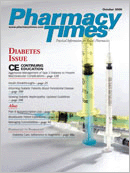Publication
Article
Pharmacy Times
Drug Name Confusion
Author(s):
Foltx-Folex
A nurse from a long-term care facilitycalled the pharmacy with an order for"Foltx, one tablet orally daily." Foltx containsfolic acid (2.5 mg), cyanocobalamin,and pyridoxine. However, the pharmacistheard the order as Folex, a discontinuedbrand of injectable methotrexate. Theorder was then entered into the pharmacycomputer as methotrexate 2.5 mgorally once daily. The error was notcaught despite several checks, so themedication was dispensed. The patientreceived methotrexate, without propermonitoring, for a few weeks and was hospitalizedwith hepatotoxicity. The errorwas discovered when a consultant pharmacistran a drug usage report forpatients on methotrexate and saw thefrequency of the order. "Daily" methotrexateshould trigger an immediate alert ineveryone, as well as in the computer system,since it is usually given only once aweek for nononcologic conditions. It isalso a drug for which a diagnosis shouldbe sought prior to dispensing or administration.In this case, it was given to apatient whose condition did not warrantit. For additional ways to prevent errorswith methotrexate, refer to the February2005 issue of this column.
Safe PracticeRecommendations
Practitioners cantake several steps tohelp prevent errorswith products that havelook-alike or sound-a-likenames.
•Prescriptions shouldspecify the drugname, dosage form,strength, completedirections, as well asits indication. Pharmacistsshould verifythe purpose of themedication with thepatient, caregiver, orphysician before it isdispensed.
•Reduce the potentialfor confusion withname pairs known tobe problematic byincluding both thebrand and genericname on prescriptions,computer orderentry screens, andprescription labels.
•When accepting verbal or telephoneorders, require staff to write down theorder on a prescription blank andthen read back (or even spell back)the medication name, strength, dose,and frequency of administration.
•Change the appearance of look-alikeproduct names on computer screensand pharmacy and product labels byemphasizing, through boldface,color, and/or "tall-man" letters, theparts of the names that are different(eg, hydrOXYzine, hydrALAzine).
•Install computerized reminders forthe most commonly confused namepairs so that an alert is generatedwhen entering prescriptions foreither drug. If possible, make thereminder auditory as well as visual.
•Employ at least 2 independentchecks in the dispensing process.
•Open the prescription bottle or packagein front of the patient to confirmthe expected appearance. Cautionpatients about error potential whentaking a product that has a look-orsound-alike counterpart. Encouragepatients to ask questions if theappearance of their medicationchanges.
Dr. Gaunt is a medication safetyanalyst and the editor of ISMPMedication Safety Alert!Community/Ambulatory CareEdition.
Subscribe toNewsletter
Pharmacy Times and the Institute for SafeMedication Practices (ISMP) would like to makecommunity pharmacy practitioners aware of apublication that is available.
The ISMP Medication Safety Alert! Community/Ambulatory Care Edition is a monthly compilationof medication-related incidents, error-preventionrecommendations, news, and editorial content designedto inform and alert community pharmacypractitioners to potentially hazardous situationsthat may affect patient safety. Individual subscriptionprices are $45 per year for 12 monthlyissues. Discounts are available for organizationswith multiple pharmacy sites. This newsletter isdelivered electronically. For more information, contactISMP at 215-947-7797, or send an e-mailmessage to [email protected].

Newsletter
Stay informed on drug updates, treatment guidelines, and pharmacy practice trends—subscribe to Pharmacy Times for weekly clinical insights.






